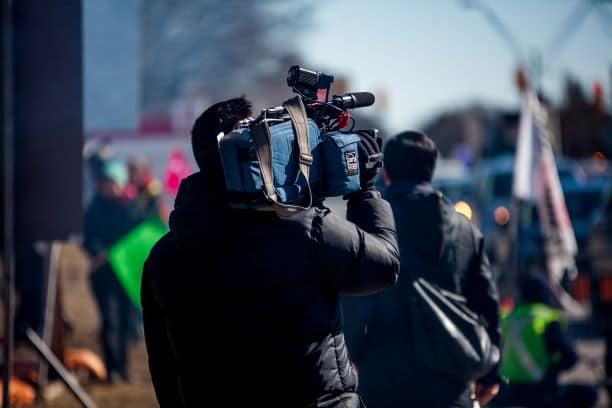We recently posted a blog on Cable television advertising. To explain how Cable advertising works, we had to contrast it to Broadcast television advertising. As promised, this is the blog post that explains the value of Broadcast TV advertising, why an advertiser would use it in their media plan for 2020 and tips for how to buy Broadcast TV advertising.

Robin Rucinsky, Media Director at Thrive Advertising
My background is in Broadcast TV sales. I sold local Broadcast TV advertising up until I left the ABC Affiliate to start Thrive Advertising in 2008. I sold Broadcast TV advertising right up until the heat of the Presidential Election of 2008. My experience in TV advertising sales launched my path to entrepreneurship.
One of our greatest values to our customers is our unique perspective and understanding of the traditional media landscape paired with our skills in digital advertising. While many agencies specialize in Traditional or Digital advertising, we’re well educated and experienced (15+ years) at both, which allows us to use both our experience and wisdom to create custom media plans that include the best media for the job. We cherry-pick the most effective media for each plan, and one of those cherries is broadcast TV advertising.
We should preface that as Media Buyers, we’re not compensated differently by different media. So we have no vested interest in recommending Broadcast TV or Cable TV or Pandora Radio or Terrestrial Radio. Our interest is our clients’ success and therefore we remain objective when making recommendations for our clients’ ad dollars.
Broadcast TV reaches a large geographic area.
In the Seattle-Tacoma DMA broadcast stations (the big ones being KING, KIRO, KOMO, Q13, KSTW) air from north of Bellingham to the south of Chehalis. Broadcast TV casts a wide net which is great for *Reach because it provides advertisers a wide coverage area to get their message out to a huge group of people.
*Reach is the percentage of your demographic that you reach with your ad campaign.
Broadcast TV stations air on all television delivery systems.
The broad *Reach ensures that you’ll be able to see ABC, NBC, Fox, CBS and CW on Comcast, Directv, Dish, and over the air (i.e. bunny ears). Broadcast stations are available in every TV household. In 2020, the Seattle market has 1,833,990 households with TV service. Broadcast TV advertising can still effective for reaching demographics like Adults 50+. Although it is always important to purchase Broadcast TV strategically and properly assess your demographic.
A lot of the value in Broadcast TV advertising for local advertisers is the local news.

Local news is the bread and butter of local TV stations’ revenue. Local news advertising gives marketers access to regional audiences who stay informed of news, weather, sports, traffic, and local lifestyles. Advertising in local news provides affordable programming for local advertisers in a quality programming environment.
Broadcast TV stations also offer syndicated programs like Wheel of Fortune and Dr. Phil. Most broadcast television syndication and local programming reach a more mature audience. They often skew female. A daytime broadcast TV advertising plan will hit the Women 50+ demo perfectly. The network affiliates also offer programs like Good Morning America and The Today Show.
Advertisers should only buy programs that aren’t likely to be recorded (news, live sports, and events), and they should stick with dayparts that are affordable enough to achieve solid Reach and *Frequency. Primetime programming is out of reach for most local advertisers. For instance, a business with a monthly budget of $20,000 might only be able to buy four commercials in primetime because the spots could cost $5,000 each! Unfortunately, four commercials won’t generate enough *Frequency to make the phone ring or site traffic spike.
*Frequency is the number of times each viewer in your demographic sees your ad during your ad campaign. Reach and Frequency are some of the ways we create traditional advertising campaigns.
Broadcast TV advertising usually provides a more affordable CPM (cost per thousand impressions) because it reaches a larger audience. It also airs most of the high profile sports events and award programs like the Super Bowl or The Grammys.
There a lot of tricks of the trade to make Broadcast TV advertising work well.
For instance, many advertisers will “flight” their ads to run two weeks on the air, then two weeks off the air. Flighting boosts Frequency in a short period of time. During the two weeks off the air, viewers don’t realize that they haven’t seen an advertiser’s ads on-air. So, when the ads resume, in double the quantity that an advertiser would have if they had stretched the ads over the full four weeks, consumers feel the Frequency spike! An advertising campaign flight strategy works because it makes an advertising budget stretch further and gives advertisers higher Frequency which is imperative for a local advertiser’s success on Broadcast TV.
Another successful TV advertising strategy is to run Bookend commercials. Bookend spots are two (:15) second commercials created to air at the beginning of a commercial break and the end. Bookends increase the Frequency and provide more exposure for less money for an advertiser. You should pay the same rate for Bookends as you would a standard (:30) spot, do not pay a premium.
Sponsored Content on Television
Did you know you that Broadcast TV stations offer Native Content advertising opportunities these days? Ever watch television segments in programs like Evening or New Day Northwest on KING 5 that look paid? They often are. You can purchase advertorial content segments in some local television programs like KOMO 4’s Seattle Refined. Paid TV segments provide a great way to generate content for social sharing, establish backlinks for SEO purposes on trusted local news websites, and offers a fun alternative to earned media for sharing your story with a broadcast audience.
Do people watch live TV anymore?
Glad you asked! Yes! In pretty impressive numbers, too! The Atlantic published a great article linked below that says, “With Netflix and Amazon Prime, Facebook Video and YouTube, it’s tempting to imagine that the tech industry destroyed TV. The world is more than 25 years into the web era, after all, more than half of American households have had home Internet for 15 years, and the current smartphone paradigm began more than a decade ago.
But no.
Americans still watch an absolutely astounding amount of traditional television.” You can read the full article here.
Programmatic TV: How to buy Broadcast TV ads through a Programmatic Ad Platform
We love technology as much as any Marketer and we relish any opportunity to save our clients money and increase the efficiency of their ad buys. There is a DSP (Demand Side Platform) specifically for Broadcast TV that allows us to reach 92% of all Broadcast Stations in the country (nearly 100% of the mid to large markets!). This Programmatic TV buying platform allows us to save our customers a fortune on the CPM! If you’re buying OTT and want to know a more efficient way to reach your demo on Broadcast TV Channels on live linear TV at a fraction of the cost, give us a call to discuss strategy. We can target dayparts and program type! It’s not just ROS and you’ll be able to select the exact Broadcast station! Knowing this will save you a ton of money this year and will increase your bottom line significantly.
How to avoid a TV Advertising Campaign Fail
Lastly, and most importantly, you must have a professional media buying strategy when you’re buying Broadcast TV advertising (or any media!). Letting experts professionally create advertising plans that reach your target demographic is the difference between successful ROI and a total campaign flop.
Unless you’re a professional media buyer, do not do your own media planning! You probably don’t invest your retirement account without guidance. Why would you invest hundreds of thousands of marketing dollars without advice?!
Also, remember that all advertising takes time. 3-6 months is the general rule. You do not want to invest in any advertising tactic for less than 3 months. You’ll lose the money. Consumers need to see or hear your ad enough times to act. Establishing enough Reach and Frequency is critically important to your ROI.
Thrive Advertising delivers media planning advice that is insightful, innovative and most notably – independent of media ownership. Contact us here to schedule a meeting to discuss your media strategy.
